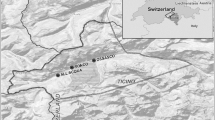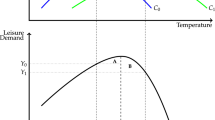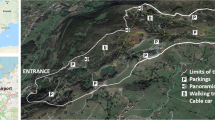Abstract
This study examines effects of weather, temporal factors, and gasoline price on outdoor recreation participation by using a time series model. We obtained more than 5 years of daily outdoor recreation visitation data by using infrared mechanical counters on a section of the Florida National Scenic Trail (FNST). Results showed that days with daily maximum temperatures of 16–22 °C brought the largest number of visitors, which suggests this is the most comfortable range of daily maximum temperatures to recreate on the FNST. Daily maximum temperatures below 6 °C and above 31 °C and heat index values above 38 °C brought significantly lower visitor numbers, suggesting these values are temperature thresholds for this region in a recreation context. A seasonal autoregressive integrated moving average model showed significant negative effects of temperature, relative humidity, cold snaps, and gasoline price and a positive effect of weekends and public holidays on recreational visitations to this trail. Days with heavy rainfall (> 2.54 cm) or a high heat index (≥ 35 °C) were likely to negatively affect recreation participation not only on the same day, but also on the next normal weather day. These findings imply that managers of facilities that need staffing and other resources should expect to receive fewer visitors on days following adverse weather conditions, even if that day has normal weather conditions.






Similar content being viewed by others
Notes
Weather refers to an atmospheric condition at any given time or place; whereas, climate refers to an average weather, or more rigorously, as the statistical description in terms of the mean and variability of relevant quantities over a period of time ranging from months to thousands of years (IPCC 2007).
References
Aikoh T, Abe R, Kohsaka R, Iwata M, Shoji Y (2012) Factors influencing visitors to suburban open space areas near a northern Japanese city. Forests 3(2):155–165
American Automobile Association (2016) Premium fuel research: proprietary research into the use of premium octane gasoline when not required by the manufacturer. American Automobile Association, Inc, Heathrow
Andrade H, Alcoforado M-J, Oliveira S (2011) Perception of temperature and wind by users of public outdoor spaces: relationships with weather parameters and personal characteristics. Int J Biometeorol 55(5):665–680
Aylen J, Albertson K, Cavan G (2014) The impact of weather and climate on tourist demand: the case of Chester zoo. Clim Chang 127(2):183–197
Bafaluy D, Amengual A, Romero R, Homar V (2014) Present and future climate resources for various types of tourism in the bay of Palma, Spain. Reg Environ Chang 14(5):1995–2006
Beaudin L, Huang J-C (2014) Weather conditions and outdoor recreation: a study of New England ski areas. Ecol Econ 106:56–68
Becken S, Hay JE (2007) Tourism and climate change: risks and opportunities, climate change, economics, and society: leadership and innovation. Channel View Publication, Victoria Road
Becken S, Wilson J (2013) The impacts of weather on tourist travel. Tour Geogr 15(4):620–639
Böcker L, Dijst M, Prillwitz J (2013) Impact of everyday weather on individual daily travel behaviours in perspective: a literature review. Transp Rev 33(1):71–91
Brandt PT, Williams JT (2001) A linear Poisson autoregressive model: the Poisson AR (p) model. Polit Anal 9(2):164–184
Brandt PT, Williams JT, Fordham BO, Pollins B (2000) Dynamic modeling for persistent event-count time series. Am J Polit Sci 44(4):823–843
Brockwell PJ, Davis RA (2002) Introduction to time series and forecasting. Springer, New York
Buckley LB, Foushee MS (2012) Footprints of climate change in US national park visitation. Int J Biometeorol 56(6):1173–1177
Butler RW (2001) Seasonality in tourism: issues and implications. In: Baum T, Lundtorp S (eds) Seasonality in tourism. Routledge, New York, pp 5–22
Cameron AC, Trivedi PK (2013) Regression analysis of count data. Cambridge University Press, New York
Chan CB, Ryan DA, Tudor-Locke C (2006) Relationship between objective measures of physical activity and weather: a longitudinal study. Int J Behav Nutr Phys Act 3(1):21
Climate-Data.org (2018) Climate: Florida. https://en.climate-data.org/north-america/united-states-of-america/florida-1000/. Accessed 10/23 2018
Coghlan A, Prideaux B (2009) Welcome to the wet tropics: the importance of weather in reef tourism resilience. Curr Issue Tour 12(2):89–104
Cools M, Moons E, Wets G (2009) Investigating the variability in daily traffic counts through use of ARIMAX and SARIMAX models: assessing the effect of holidays on two site locations. Transp Res Rec 2136:57–66
de Freitas CR (2015) Weather and place-based human behavior: recreational preferences and sensitivity. Int J Biometeorol 59(1):55–63
de Freitas CR (2017) Tourism climatology past and present: a review of the role of the ISB commission on climate, tourism and recreation. Int J Biometeorol 61(1):107–114
de Freitas CR, Scott D, McBoyle G (2008) A second generation climate index for tourism (CIT): specification and verification. Int J Biometeorol 52(5):399–407
De Urioste-Stone SM, Scaccia MD, Howe-Poteet D (2015) Exploring visitor perceptions of the influence of climate change on tourism at Acadia National Park, Maine. J Outdoor Recreat Tour 11:34–43
Denstadli JM, Jacobsen JKS, Lohmann M (2011) Tourist perceptions of summer weather in Scandinavia. Ann Tour Res 38(3):920–940
Dubois G, Ceron J-P, Gössling S, Hall CM (2016) Weather preferences of French tourists: lessons for climate change impact assessment. Clim Chang 136(2):339–351
Dwyer JF (1988) Predicting daily use of urban forest recreation sites. Landsc Urban Plan 15:127–138
Finger R, Lehmann N (2012) Modeling the sensitivity of outdoor recreation activities to climate change. Clim Res 51(3):229–236
Fogarty BJ, Monogan JE (2014) Modeling time-series count data: the unique challenges facing political communication studies. Soc Sci Res 45:73–88
Gössling S, Scott D, Hall CM, Ceron J, Dubois G (2012) Consumer behaviour and demand response of tourists to climate change. Ann Tour Res 39(1):36–58
Hamilton JM, Lau MA (2005) The role of climate information in tourist destination choice decision making. In: Gössling S, Hall CM (eds) Tourism and global environmental change: ecological, economic, social and political interrelationships. Routledge, London, p 229
Hamilton LC, Brown C, Keim BD (2007) Ski areas, weather and climate: time series models for New England case studies. Int J Climatol 27(15):2113–2124
Hewer MJ, Gough WA (2016) Weather sensitivity for zoo visitation in Toronto, Canada: a quantitative analysis of historical data. Int J Biometeorol 60(11):1645–1660
Hewer MJ, Scott D, Gough WA (2015) Tourism climatology for camping: a case study of two Ontario parks (Canada). Theor Appl Climatol 121(3–4):401–411
IPCC (2007) Climate change 2007: the physical science basis. Working group I contribution to the fourth assessment of the intergovernmental panel on climate change. Cambridge University Press, New York
IPCC (2014) Climate change 2014: synthesis report. contribution of working groups I, II and III to the fifth assessment report of the intergovernmental panel on climate change. Geneva, Switzerland
Jones B, Scott D, Khaled HA (2006) Implications of climate change for outdoor event planning: a case study of three special events in Canada's National Capital region. Event Manag 10(1):63–76
King G (1989) Event count models for international relations: generalizations and applications. Int Stud Q 33(2):123–147
Kottek M, Grieser J, Beck C, Rudolf B, Rubel F (2006) World map of the Köppen-Geiger climate classification updated. Meteorol Z 15(3):259–263
Li C, Lin S-H (2012) Influence of weather conditions on hiking behavior. Int J Biometeorol 56(4):777–781
Lin T-P (2009) Thermal perception, adaptation and attendance in a public square in hot and humid regions. Build Environ 44(10):2017–2026
Lin T-P, Matzarakis A (2008) Tourism climate and thermal comfort in sun moon Lake, Taiwan. Int J Biometeorol 52(4):281–290
Lin TP, de Dear R, Hwang RL (2011) Effect of thermal adaptation on seasonal outdoor thermal comfort. Int J Climatol 31(2):302–312
Lindner-Cendrowska K, Błażejczyk K (2018) Impact of selected personal factors on seasonal variability of recreationist weather perceptions and preferences in Warsaw (Poland). Int J Biometeorol 62(1):113–125
Lindsey G, Wilson J, Rubchinskaya E, Yang J, Han Y (2007) Estimating urban trail traffic: methods for existing and proposed trails. Landsc Urban Plan 81(4):299–315
Lohmann M, Kaim E (1999) Weather and holiday destination preferences image, attitude and experience. Tour Rev 54(2):54–64
Manning RE, Powers LA (1984) Peak and off-peak use: redistributing the outdoor recreation/tourism load. J Travel Res 23(2):25–31
McEvoy D, Handley J, Cavan G, Aylen J, Lindley S, McMorrow J, Glynn S (2006) Climate change and the visitor economy: the challenges and opportunities for England’s northwest. Sustainability Northwest (Manchester) and UKCIP (Oxford)
McGinn AP, Evenson KR, Herring AH, Huston SL (2007) The relationship between leisure, walking, and transportation activity with the natural environment. Health Place 13(3):588–602
Mieczkowski Z (1985) The tourism climatic index: a method of evaluating world climates for tourism. Can Geogr/Le Géographe Canadien 29(3):220–233
Montgomery DC, Jennings CL, Kulahci M (2008) Introduction to time series analysis and forecasting. Wiley, Hoboken
Morgan R, Williams A (1999) Video panorama assessment of beach landscape aesthetics on the coast of Wales. J Coast Conserv 5(1):13–22
Napier TL, Bryant EG (1980) The impact of increasing fuel costs on future outdoor recreation participation. The Ohio State University. https://kb.osu.edu/bitstream/handle/1811/67373/CFAES_ESO_770.pdf?sequence=1&isAllowed=y. Accessed 25 Jan 2016
National Centers for Environmental Information (2016) Climate data online. National Ocenic and atmospheric administration. https://www.ncdc.noaa.gov/cdo-web/. Accessed 25 Jan 2016
Nau R (2017) What’s the bottom line? How to compare models. https://people.duke.edu/~rnau/compare.htm. Accessed 27 June 2017
Ndetto EL, Matzarakis A (2017) Assessment of human thermal perception in the hot-humid climate of Dar Es Salaam, Tanzania. Int J Biometeorol 61(1):69–85
Nicholls S, Holecek DF, Noh J (2008) Impact of weather variability on golfing activity and implications of climate change. Tour Anal 13(2):117–130
Paudyal R (2017) Motivational, forest management, and climatic factors affecting outdoor recreation participation and experience in Florida. Dissertation, University of Florida, Gainesville, Florida
Paudyal R, Poudyal NC, Bowker JM, Dorison AM, Zarnoch SJ, Green GT (2015) A value orientation approach to assess and compare climate change risk perception among trout anglers in Georgia, USA. J Outdoor Recreat Tour 11:22–33
Pergams OR, Zaradic PA (2006) Is love of nature in the US becoming love of electronic media? 16-year downtrend in national park visits explained by watching movies, playing video games, internet use, and oil prices. J Environ Manag 80(4):387–393
Perkins DR (2018) Using synoptic weather types to predict visitor attendance at Atlanta and Indianapolis zoological parks. Int J Biometeorol 62(1):127–137
Richardson RB, Loomis JB (2004) Adaptive recreation planning and climate change: a contingent visitation approach. Ecol Econ 50(1–2):83–99
Rothfusz LP (1990) The heat index equation (or, more than you ever wanted to know about heat index). Scientific Services Division, National Weather Service - Southern Region Headquarters, Fort Worth
Rutty M, Andrey J (2014) Weather forecast use for winter recreation. Weather Clim Soc 6(3):293–306
Rutty M, Scott D (2013) Differential climate preferences of international beach tourists. Clim Res 57(3):259–269
Rutty M, Scott D (2015) Bioclimatic comfort and the thermal perceptions and preferences of beach tourists. Int J Biometeorol 59(1):37–45
Scott D, Lemieux C (2010) Weather and climate information for tourism. Procedia Environ Sci 1:146–183
Scott D, Gössling S, de Freitas CR (2008) Preferred climates for tourism: case studies from Canada, New Zealand and Sweden. Clim Res 38(1):61–73
Scott D, Gössling S, Hall CM (2012) International tourism and climate change. Wiley Interdiscip Rev Clim Chang 3(3):213–232
Scott D, Rutty M, Amelung B, Tang M (2016) An inter-comparison of the holiday climate index (HCI) and the tourism climate index (TCI) in Europe. Atmosphere 7(6):80
Sheridan SC (2007) A survey of public perception and response to heat warnings across four north American cities: an evaluation of municipal effectiveness. Int J Biometeorol 52(1):3–15
Sheridan SC, Allen MJ (2015) Changes in the frequency and intensity of extreme temperature events and human health concerns. Curr Clim Chang Rep 1(3):155–162
Shih C, Nicholls S, Holecek DF (2009) Impact of weather on downhill ski lift ticket sales. J Travel Res 47(3):359–372
Smith K (1993) The influence of weather and climate on recreation and tourism. Weather 48(12):398–404
Smith TT, Zaitchik BF, Gohlke JM (2013) Heat waves in the United States: definitions, patterns and trends. Clim Chang 118(3–4):811–825
Spagnolo J, de Dear R (2003) A human thermal climatology of subtropical Sydney. Int J Climatol 23(11):1383–1395
Steiger R, Abegg B (2018) Ski areas’ competitiveness in the light of climate change: comparative analysis in the eastern Alps. In: Müller D, Więckowski M (eds) Tourism in transitions. Geographies of tourism and global change. Springer, Cham, pp 187–199
Steiger R, Abegg B, Jänicke L (2016) Rain, rain, go away, come again another day. Weather preferences of summer tourists in mountain environments. Atmosphere 7(5):63
Steiger R, Scott D, Abegg B, Pons M, Aall C (2017) A critical review of climate change risk for ski tourism. Curr Issue Tour:1–37
Tervo K (2008) The operational and regional vulnerability of winter tourism to climate variability and change: the case of the Finnish nature-based tourism entrepreneurs. Scand J Hosp Tour 8(4):317–332
U.S. Energy Information Administration (2016) Weekly retail gasoline and diesel prices. https://www.eia.gov/dnav/pet/pet_pri_gnd_dcus_sfl_w.htm. Accessed 01/25 2016
Verbos RI, Altschuler B, Brownlee MT (2018) Weather studies in outdoor recreation and nature-based tourism: a research synthesis and gap analysis. Leis Sci 40(6):533–556
Wan B, Paudyal R, Huntley C, Stein T (2014) Florida National Scenic Trail Visitor Assessment. School of Forest Resources and Conservation, University of Florida, Gainesville
Wilkins E, De Urioste-Stone SM, Weiskittel A, Gabe T (2017) Effects of weather conditions on tourism spending: implications for future trends under climate change. J Travel Res 57(8):1042–1053
Yu G, Schwartz Z, Walsh JE (2009) A weather-resolving index for assessing the impact of climate change on tourism related climate resources. Clim Chang 95(3):551–573
Zhang F, Wang XH (2013) Assessing preferences of beach users for certain aspects of weather and ocean conditions: case studies from Australia. Int J Biometeorol 57(3):337–347
Author information
Authors and Affiliations
Corresponding author
Rights and permissions
About this article
Cite this article
Paudyal, R., Stein, T.V., KC, B. et al. Effects of weather factors on recreation participation in a humid subtropical region. Int J Biometeorol 63, 1025–1038 (2019). https://doi.org/10.1007/s00484-019-01715-z
Received:
Revised:
Accepted:
Published:
Issue Date:
DOI: https://doi.org/10.1007/s00484-019-01715-z




